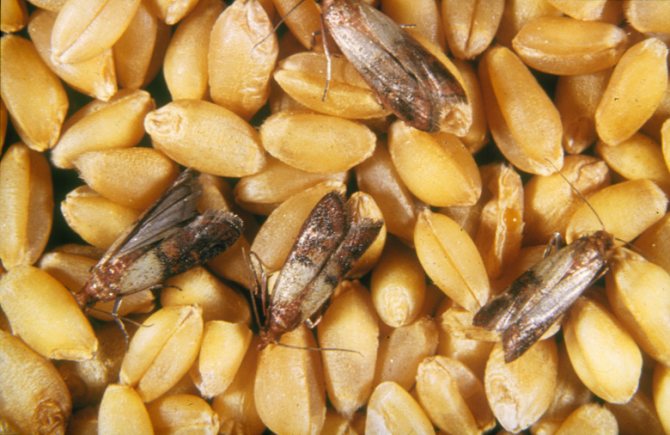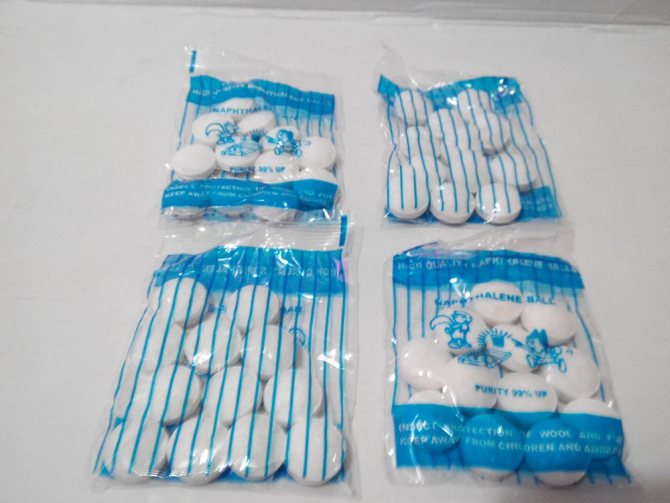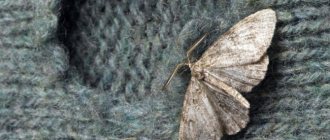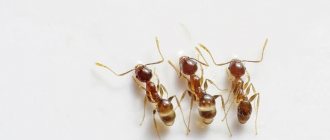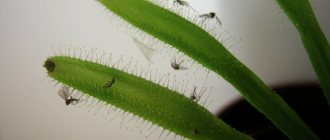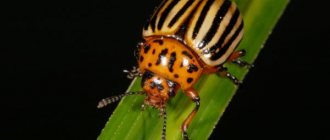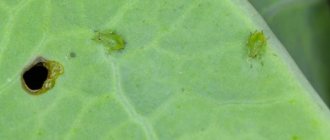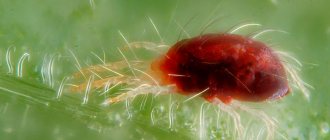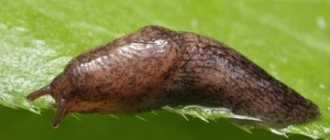| A place | Name | Feature in the rating |
| The best moth aerosols |
| 1 | Armol | The optimum ratio of price and quality |
| 2 | Raptor | Highest efficiency |
| 3 | DR. KLAUS | Large volume and unobtrusive smell |
| 4 | ARGUS | Best price |
| 5 | Taiga Antimol | A good tool for control and prevention |
| The best remedies for moths in the closet |
| 1 | Raid pads | Most popular remedy |
| 2 | Sachet Aeroxon | Best composition, safety |
| 3 | DR. KLAUS | Plates for the destruction of odorless moth larvae |
| 4 | Pills Clean House | Affordable price and efficiency |
| 5 | Delicia Mottenschutz Lure | Effective and economical |
Cabinets smelling of mothballs are a thing of the past. Nowadays, stores sell a variety of moth repellents that work effectively and smell nice. They can be roughly divided into two categories - aerosols for spraying in an apartment (they usually act on other insects as well) and various sachets, plates that are hung in the closet to protect clothes from being eaten by moths. The choice of funds is huge, from well-known and not so famous manufacturers, the effectiveness is also different. But you can choose the best option. Get rid of harmful insects faster will help you rating the best moth repellents.
Folk remedies
Since moths have been adjacent to humans since ancient times, different methods of dealing with butterflies and caterpillars have been invented and tested. The smell of certain plants helps to repel the parasite. Household chemicals are also used.
Moth tansy
Tansy flowers are harvested in summer. Grass is hung in bunches in the kitchen. You can put dried inflorescences in linen bags and spread them on the shelves of the cabinet. The smell of tansy repels insects, but does not kill them.
Wormwood herb
The strong bitter smell of wormwood effectively affects insects in the apartment. They leave a person's dwelling. Butterflies will not fly through the window if the smell of wormwood comes from there.
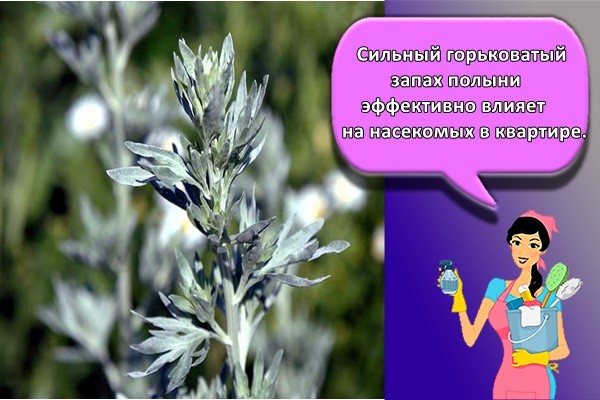
Lavender
Lavender flowers have a wonderful repelling effect. The dried herb sachet can be laid out in the dressing room. It is helpful to keep pouches of lavender in the kitchen.
Mint
Mint sprigs spread the scent throughout the apartment. It is worth putting bags of dried grass next to a fur coat stored on a hanger, inside woolen blankets and clothes. The moth will never settle where it smells of mint.
Orange peels
Citrus peels should not be thrown away. Fresh, they spread the scent throughout the home. Lepidoptera do not like this smell. If a gray moth starts up, it will quickly leave the apartment.
Caucasian chamomile
Dried chamomile flowers from the Caucasus have a strong odor. Inside the plant is the poisonous substance pyrethrum, which is used against many household insect pests. But it is safe for humans. Chamomile powder is poured into the hidden corners of the cabinet to destroy the moth, its larvae.
Geranium
Geranium has a deterrent effect. Often flower pots help to cope with pests at home and plants. Frightens off the aroma of a flower and moths. It is unlikely that a butterfly will fly into a house where geraniums bloom on the windowsills. Therefore, it is necessary to use a flower for protection from insects.
Horse chestnut
When the chestnut blossoms, white candles are collected. They are ground into powder, placed in bags. Chestnuts are also laid out on shelves. They will protect clothing and food from moths throughout the year.


Vinegar and garlic
Vinegar is used to wipe the surfaces inside the cabinets during cleaning.Remaining on the walls, doors of furniture, the substance will protect the house from parasites. Garlic has a strong smell, which will also help scare away the butterfly. It is better to lay out the cloves in the kitchen. You can make gruel out of them, lubricating the hidden corners where the moth starts. But in the wardrobe, the garlic smell will permeate the clothes.
Scented tobacco
Flowers of tobacco have a pronounced aroma, which allows the plant to be used in the fight against pests. Plants are dried and filled with pads, bags. They are suitable for unfolding on shelves in all areas of the house.
Fragrant herbs
Many plants that are pleasant to humans cannot tolerate flying insects. They do not like the aroma of eucalyptus, strawberries, pine needles, citrus fruits. Instead of a sachet, you can put soap with a corresponding smell inside the wardrobe.
Essential oils
They use aromatic oils in the fight against insects. They are filled with special lamps to freshen the air. Moistening cotton pads with 1-2 drops of eucalyptus, clove, lavender, fir oils can help protect your home from harmful insects.
Naphthalene
Mothballs are still in demand today for moth control. But if earlier clothes were impregnated with the smell of powder, now fragrances are added to the preparation.
Burnt honey
A mole leaves the apartment if it smells honey heated over a fire. If you overheat the product a little above the norm, then the pests will fly out of the house.


Lemon thyme
All against the same mosquitoes. This hardy herb can adapt to dry or stony, shallow soil and will thrive in your garden when placed in sunny locations.
The plant itself will not repel annoying mosquitoes. To release its chemicals, you have to crush the leaves. To do this, simply cut off a few stems and rub them between your hands.
But before you do this, make sure you are not allergic to thyme oil. To do this, rub the leaves of the plant on a small area on your forearm for several days.
Rosemary repels mosquitoes and other plant-damaging insects. Rosemary is available in a variety of forms today. Plants can be grown in patio pots and formed into ornamental shrubs in the garden (some varieties can grow quite large). Rosemary is also great in cooking. The plant and its cuttings are themselves effective repellents.
We suggest you familiarize yourself with: How to get rid of food moths in the kitchen
You can make a simple spray repellent: boil 500 grams of dried rosemary in a liter of water for 20 to 30 minutes. Then cool and pour into a container with a dispenser. Store the solution in the refrigerator!
Other herbs:
- Bay leaf: repels flies. Dried bay leaves, which are sold in stores for soups and stews, are not suitable. Therefore, grow bay leaves at home.
- Onion: scares off flies, Japanese beetle (aka Japanese beetle) and aphids.
- Dill: against aphids, margins, spider mites, scoops, cabbage and hawk moths.
- Fennel: Will help fight aphids, slugs and snails.
- Melissa officinalis: repels mosquitoes.
- Oregano: repels many pests and adds moisture to the soil cover.
- Parsley: repels various beetles.
- Thyme: scares off whiteflies, scoopers, etc.
Before you get rid of food moths with folk remedies, you should take a closer look at various spices. In kitchens and cabinets, there are bags or pouches with cloves, as well as thyme and rosemary. They give off such a strong aroma that the likelihood of pests appearing next to the bags is minimal.
Folk remedies to help get rid of moths
Most people prefer to deal with insects without using any harmful chemicals, entrusting the whole process to exclusively folk and completely safe means.At least, it is believed that a folk remedy means safe. As for toxicity, the issue is very controversial, but the fact that the price is usually much cheaper is a fact. However, when using such funds, it should be borne in mind that most of them do not kill, but only scare away moths.
So, the main helpers in the fight against harmful insects in the form of moths are:
- Lavender. This plant, or rather essential oils, of which there are quite a lot in its composition, gives a good effect when repelling small insects. All thanks to the strong and for many people a rather pleasant aroma of this plant. If possible, you can stock up on lavender flowers and dry them; if not, you can purchase ready-made lavender oil at your nearest perfume shop. Dry inflorescences of the plant can be put in a linen bag and left on different shelves of the cabinet. If oil is used, you can make several small holes in the cork of the container containing it and place the bottles in your cabinet in the same way.
- Citrus scents can be used to ward off food moths. The peels of lemons, tangerines, oranges and other fruits can be laid out on the shelves in the cupboards and you can expect the effect. You need to know that citrus peels and zest dry out quickly, so with a certain frequency, such repellents will have to be changed. By the way, if insects have already managed to lay their eggs, it is impossible to destroy them by smell alone.
- Fresh pieces of scented soap can be packaged in small pieces in cloth bags and used to tuck clothes in the closet. The disadvantage of this method is that the clothes will absorb a large amount of soapy odor, so if this bothers someone, then this option is not very suitable, although you can pick up the soap by smell.
- Table vinegar and garlic. The pungent smell that comes from these products is quite capable of scaring off not only moths, but various other animals. The use of such a folk remedy is desirable in the fight only against moths, which are divorced in products, since wearing clothes that smell of garlic is not very pleasant, but a place on the bus and a few more in a circle is provided. You can use these funds alone, and in order to achieve the maximum "lethal" effect, you can mix them together.
- Exposure to temperature. We partially mentioned this option in the previous paragraph. Adult moths and insect larvae are very afraid of cold and intense heat. When exposed to direct sunlight, at temperatures over thirty degrees, they cannot survive in woolen fabrics. The same effect will occur if the thermometer reading drops below minus ten degrees Celsius.
By the way, not only lavender helps to cope with harmful insects, but also some other odorous plants. For example, these include strawberries, eucalyptus, chestnuts, or ordinary pine needles. For example, chestnuts can be simply laid out in clothing pockets, as well as in linen bags, by placing them there with a sprig of lavender and a little pine needles. Dried tansy blossoms will work well as a deterrent.
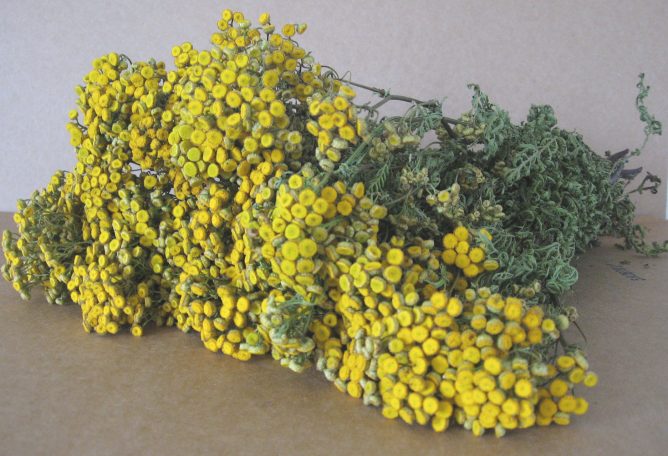

Strawberry smell repels pests. If it is not possible to apply the plant itself, strawberry soap or any perfume with a similar scent will suffice.
It should be noted that the concentration of aroma and the effect of repelling moths directly depend on each other. The volumes of vegetable oils in plants are limited, and they themselves have a very high volatility, therefore, over time, the quality and strength of the aroma decreases, thereby increasing the possibility of moth appearance.
But the beneficial effect of chestnut nuts can generally last a very long time, up to 2-3 years. In addition, moths will not appear for a long time if essential oils with suitable scents are used instead of herbs, preferably without aromatic inclusions.
If you need to find a permanent assistant in the fight against these harmful insects, it is better to find geranium flowers. This is a wonderful answer to the question: how to destroy moths with folk remedies, which were owned by the great-grandmothers of our great-grandmothers. Most pests simply cannot stand the smell of this plant, and the moth generally tries to keep it away from it. It is worth putting a pot with this plant in every room, this will help not only get rid of the moth that accidentally got into the room, but also prevent the appearance of a new one.
Essential oils
Essential oils are an excellent and very effective folk remedy for repelling moths. In addition to the eucalyptus composition, lavender, fir, clove, lemon and rosemary oils are widely used. Insects don't like their fragrant aroma.
It is not difficult to apply essential oils for moths. It is enough to add a few drops of any oil to a container of water and wipe the shelves in the cabinets, the floor, kitchen surfaces and furniture in the room with it. You can also spray the surface of upholstered furniture with this solution.
Important! To enhance the effect, cotton swabs soaked in oil will help, which must be laid out in each room.
Lavender
The sophisticated scent of lavender, which is included in the aromas of many cosmetic and perfumery products, is very unpleasant for moths. This feature of the plant is used in the development and manufacture of industrial products. At the pharmacy, you can buy lavender-based essential oil, soak napkins with it and lay out on the shelves with linen.
In a closet with outerwear, patches with lavender scent are tied in a knot on the crossbar or laid out in the pockets of fur coats and sheepskin coats. This method is good in that the clothes taken from the wardrobe do not exude a chemical aroma, but smell quite nice.


If there are bunches of lavender flowers, then you can use them:
- Dry flowers are laid out in the back of the shelves.
- For each shelf, 3 to 4 sprigs of lavender are enough.
- As the fragrance wears off, the flowers change.
- Store the stock in a tightly closed container. Better if it is glassware.
When sending warm blankets for summer storage, dry them in the sun and, shifting with lavender sprigs, pack them in bags. In sealed packaging, lavender aroma lasts much longer than on cabinet shelves, so dried flowers can not be changed.
Storage and care rules
To enhance the effect, you must follow these rules:
- After washing, all wardrobe items are rinsed. Extracts or essential oils are added to the water. The use of covers treated with repellents, aerosols and sprays is allowed.
- The sachets placed in the closet are changed every 1-1.5 months. Indeed, over time, they do not release the required components into the air.
- Fur and woolen products are ventilated and dried at room temperature.
- When choosing repellent herbs, it is necessary to take into account the personal preferences and recommendations of the masters that all pests have disappeared from the scent of flowers.
The effectiveness of herbal repellents largely depends on the correct selection. Indeed, for some species of moths, plants with certain characteristics are required.
What she is and where she lives
An adult butterfly does not eat anything, feeds only on water droplets. But at the caterpillar stage, she eats a lot, because she needs energy reserves for future development. This is why it is dangerous.
Most of all, food moth loves to multiply in cereals, pasta, beans, dried fruits, nuts. Small worms eat there, leaving their waste products. As a result, clean cereal turns into a spoiled, unusable product. Not only is it completely refined, turned into dust, but insect scales, their feces, cobwebs and the like are still left in it.Who will eat this? So the question arises, how to deal with food moths in order to preserve food, and how to get rid of it completely?
It should be remembered that the caterpillar of the food moth is polyphagous, it eats many foods, but prefers:
- rice;
- millet;
- dried apricots;
- raisins;
- pears and apples.
They must be examined first of all in order to destroy the nests of the pest. The moth caterpillar causes great harm to the seeds intended for sowing, since it gnaws out the embryo. She also eats chocolates, seasonings, tea - in general, almost any food around her. She does not eat clothes, carpets or upholstery.
A food moth can get into the seeds by air, flying through a ventilation shaft or through an open window in an apartment. Larvae can also survive in poorly processed foods. To avoid this, it is advisable to buy cereals in transparent packages or in bulk and inspect the contents well.
How plants repel insects
Plants contain organic compounds - essential oils. They are found in different parts: leaves, flowers, roots, fruits and seeds. For effective pest control, use those parts that contain the most essential substances.
Many are interested in how a moth smells a referent if its source is hidden in a closed cabinet. According to research by microbiologists, the pest butterfly is able to sense the minimum amount of odor at a distance of 1 mile. She easily smells an unpleasant substance behind the cabinet doors.
Do not be afraid that moths will not be able to scare away repellents, the smell of which a person does not smell. Pests will not fly the room where horse chestnuts are spread out, although their smell is not perceptible to people.
The essential smell does not kill moth eggs and larvae, but only scares off adult insects. Odorous substances are used for prevention, and not for the destruction of pests. Therefore, it is necessary to observe precautions when storing food and clothing:
Only clean things are placed in wardrobes, which are pre-treated with chemical insecticides or essential oils. The smell of unwashed clothes attracts pests; moth larvae willingly eat contaminated parts. Bulk products, in which the mole starts up, are stored in tightly closed containers. Food should not be allowed to get wet, as pest larvae prefer a humid environment. What herbs scare away moths
What is a mole
What you need to know about the moth and how to deal with it These questions should be understood before the very process of the struggle, in order to know exactly how to inflict a fatal blow on the moth. A moth is a kind of butterfly, or rather, even to say that a moth is a keratophagous insect. Keratophages are usually called living organisms that prefer to feed on horny substances that contain keratin.
Keratin is a protein of the fibrillar family that has mechanical strength. For example, our nails, hair, beaks of birds, horns of animals are made of keratin.
Fibrillar proteins are proteins that have an elongated structure and a filamentous structure, and most of these proteins are insoluble in water.
Nepentes
Nepentes is an insect trap. This exotic plant lures insects into its pitcher with its nectar, aroma and color. The doors slam behind the insect and it finds itself in a puddle of water.
In the water, the insect drowns or dies of exhaustion, trying to escape, which is impossible because of the closed "doors". The plant then digests the insect.
The insects most commonly prey to this North American plant are ants, flies, wasps, bees, beetles, slugs, and snails.
Napenthes grow in swamps in the wild, they need a sunny area that always remains moist. This is usually quite a challenge for home gardeners.
You need to grow a flower in pots placed in a saucer of water. However, do not overdo it with the liquid, it should only be damp.
Prophylaxis
It is necessary to prevent the appearance of moths in the apartment by folding and hanging clothes in the closet in their pure form. When putting shoes in boxes, remove the insoles.
Store cereals and flour in sealed containers. You should look there more often. If worms appear, discard the cereal. Rinse and dry the containers. It is better to purchase bulk products in stores, and not from hands. Moth lays eggs in nuts. Therefore, you do not need to store them for a long time. Better to buy fresh food rather than expired. It is impossible for the room to have high humidity. So the moth will definitely start. If the food is sorted out often, then the pests will not start.
You can put cigarettes in the pockets of winter clothes, their smell will help to avoid the attack of the butterfly. Fragrant herbs and orange peels are placed in the cupboards. These herbal remedies will be a reliable protection against the appearance of moths in the house. You can put dried orange peels in bowls, mixing them with pepper. To protect blankets, blankets from moths, bay leaves wrapped in gauze are used.
Share link:
Precautions
Fighting moths with folk remedies, despite the seeming safety, requires caution. The use of substances with a strong odor can lead to allergic reactions. Contact with the skin of some essential oils in their pure form can cause burns, therefore, before use, they are diluted in milk or vegetable oil.
The use of traditional methods of fighting moths is quite effective; with their complex use, you can both get rid of moths with folk remedies and prevent its appearance. Household insecticides should be used if you need to get rid of insects quickly or if their numbers are high.
Prevention of the appearance of moths
Any folk remedy has a pungent odor that drives away adults. These substances do not act on pupae and larvae, therefore they can only be used to prevent the appearance of insects.
Naphthalene
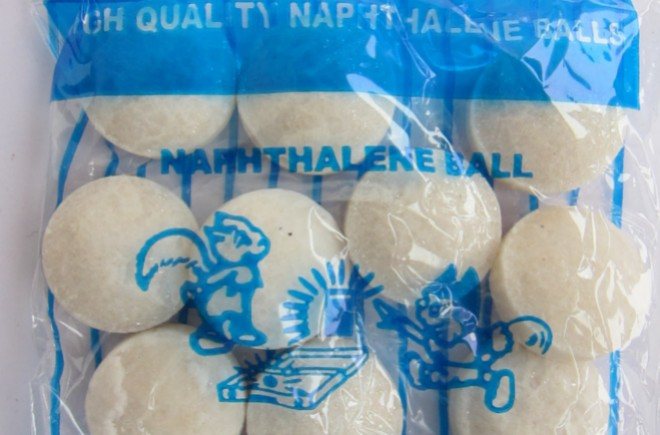

More recently, to the question of how to get rid of moths in an apartment once and for all, there was only one answer - to use mothballs. It came in pill form and was widely used. More recently, it has been proven that naphthalene vapors are dangerous not only for insects, but also for humans, they can lead to genetic disorders and cancer. In 2007, naphthalene was banned in Europe, but in our country it can still be purchased.
Fragrant herbs
There are many plants that are absolutely safe and have an attractive smell for humans, and at the same time are able to scare away moths. As a rule, they contain a large amount of essential oils.
Lavender is a proven insect repellent for a long time, it has a pleasant smell and a long duration of action - up to 2 months. To use lavender against clothes moth, it is placed in fabric or perforated paper bags, which are laid out on shelves and placed in clothing pockets.
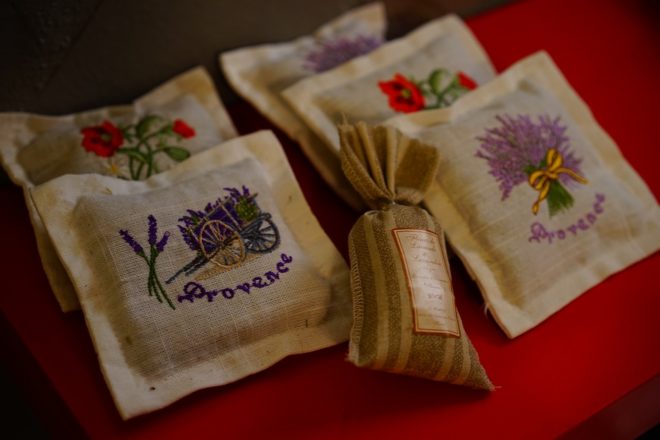

Bitter wormwood and tansy are more readily available than lavender, but the effect is no worse. Both dry bunches of these herbs and fresh plants can be placed in cabinets. When using fragrant herbs, you need to regularly check whether they have eroded, and replace them in a timely manner. This usually has to be done once a month.
You can use these plants in a concentrated form; ready-made essential oil is useful for this. In addition to lavender and wormwood oils, you can use rosemary, mint, clove and eucalyptus, as well as citrus and coniferous scents.


Use essential oils against moths as follows:
- cotton wool soaked in a fragrant composition is placed in a closet so that they do not touch clothing;
- a few drops are added to the water for cleaning;
- the cabinet inside and outside is sprayed with essential oil using a spray bottle.It is better not to get on the fabric, as there may be stains from the vegetable oils included in the composition.
Houseplants
Afraid of moths and some indoor flowers. Traditional geranium bushes serve not only to decorate the window, but also to protect against flying insects. To prevent the appearance of moths, a few pots of geranium, pelargonium or scented tobacco are enough.


Plectrantus, a hanging plant with rounded toothed leaves, also has a strong spicy smell. It is also called indoor mint or molar tree. To scare away moths, crushed room mint leaves are laid out in the moths' habitats.
Other smells
An old remedy for moths is ordinary tobacco. Clothes from it acquire a specific smell, so it is inappropriate to use tobacco in everyday life. But when sending things for long-term storage, it is irreplaceable. Dry tobacco mixed with chamomile is sprinkled on carpets, blankets, winter shoes before packing. Before use, things are vacuumed and ventilated.
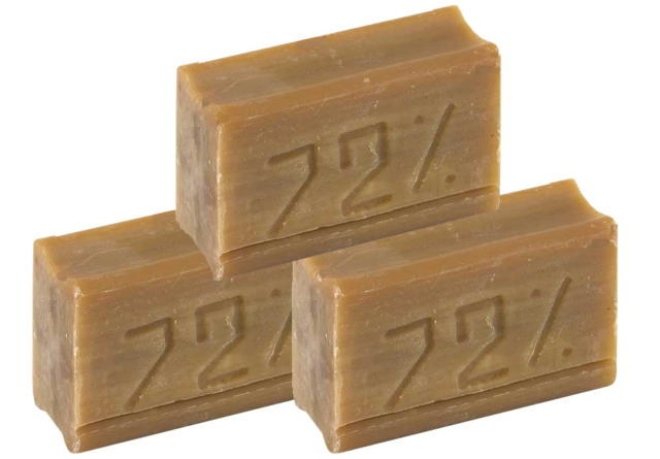

Scares away moths and laundry soap. They put it in the pockets of clothes, put it in shoes, rub it with soap on the backs of cabinets and the underside of carpets.
Horse chestnut
It is believed that chestnuts also help with moths. This is not entirely true. Moreover, the most common horse chestnut itself suffers greatly from the chestnut mining moth, its larvae literally destroy the leaves even before the onset of autumn. Leaves and fruits of horse chestnut and red horse chestnut are poisonous for insects.
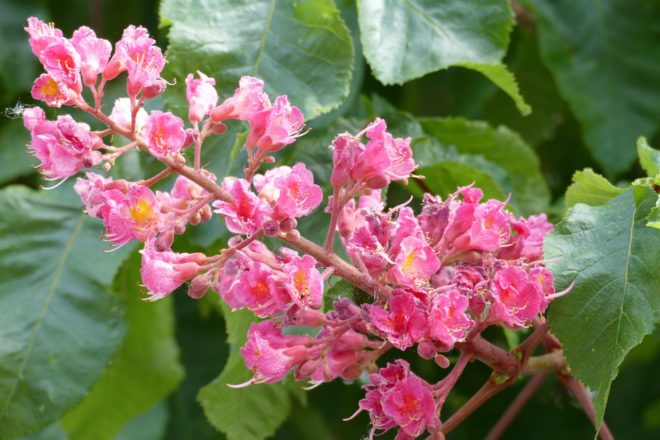

Both species are rarely found in cities; it is almost impossible to find them in the wild thickets. These plants can be distinguished by their bright pink inflorescences. If it is possible to collect the fruits of these trees, they need to be dried and crushed to spread in insect habitats.
Protection against moths in the kitchen
In the kitchen, the use of strong odors is limited. Groceries easily absorb all odors, so it is better to use substances that cannot spoil the taste of dishes:
- bay leaves, cloves of garlic are placed in jars with cereals;
- fresh orange and lemon peels are laid out on the shelves of the cabinets, placed in the bread bin;
- vinegar is added to the water when cleaning; 100 grams of it is enough for a bucket of water.


Plants growing in the wild
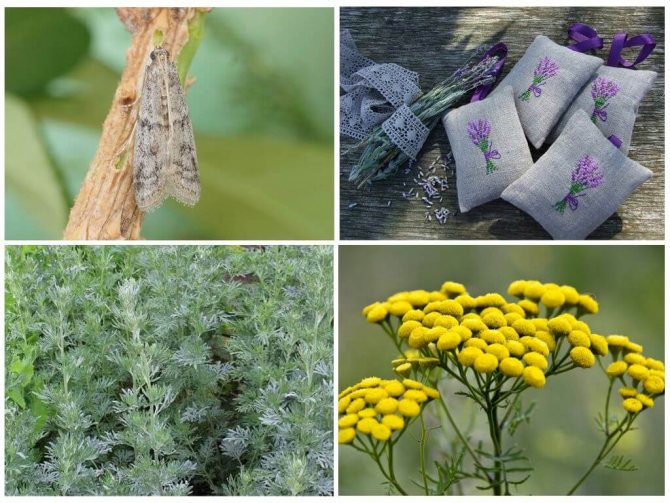

Plants that repel moths
If you ask any housewife what is the name of the plant that is most often used for moths, everyone will answer - this is lavender, which has a very strong and pleasant smell. In nature, it grows in the Mediterranean region, in the southern regions of Russia, some gardeners grow it in the middle lane. Its advantage is the preservation of the aroma for a long time, and the effectiveness of the action on a mole of dried flowers or essential oil is almost the same. It is widely used in industry, cosmetics and perfumery.
To scare away moths, lavender twigs or bags of dry grass should be laid out on shelves in closets, between stacks of linen and clothes. The essential oil is placed in an open bottle. Spraying things with lavender decoction also works well, but this treatment must be repeated regularly, since the vapors quickly dissipate.
On a note!
It is not recommended to use essential oils for processing things, since they can leave greasy stains on them that are poorly removed.
Folk ways to combat moths also use other herbs:
- Tansy - grows on the territory of Russia not only in the forest, but also on the wasteland, and along the road, is distinguished by bright yellow flowers collected in inflorescences, popularly called "wild mountain ash", is widely used as an anthelmintic. Not only moths are afraid of its smell, but also other flying and crawling insects. Tansy is harvested in the summer in the forest or in dried form is bought in a pharmacy, and at home they are laid out in places where butterflies can settle.
- Wormwood is a herb that is found everywhere in forests and fields.Both fresh and dry stems and leaves emit a pungent aroma, and a useful tincture is also made from it. Wormwood from moths in the form of a decoction or infusion can be added to the water when wet cleaning the room and wiping the furniture, this will scare away moths and save the apartment from unwanted guests.
- Ledum - blooms like a shrub with white flowers throughout the summer, very popular both in medicine and in the fight against domestic pests. The plant is poisonous, so protective measures must be taken when harvesting it, since the smell can cause nausea and dizziness. They put in closed cabinets only in small portions, which will scare away moth butterflies, but for a person the aroma will be imperceptible.
- Rosemary, a flower that can be grown at home, also emits a specific aroma that flying pests do not like; essential oil is also made from the plant. To scare away, the leaves are laid out on furniture shelves, but they must be replaced often.
- Lemon mint is a herb from moths, which has a pleasant aroma for a person's sense of smell, which will scare away butterflies and create a favorable aura in the apartment.
- Thyme or thyme - a folk remedy for moths is used dried: they fill the bags with it and put them on the shelves in the wardrobe between woolen or fur clothes.
- Immortelle - flower-stalks of this plant from moths in a dried form can lie for years, a flying pest does not tolerate its sharp smell.
Moths are also repelled by the smell of printing ink and fresh newspapers. Therefore, if you shift things with newspaper sheets, it will help save them from "being eaten".
Moth species
At first glance, all species of moths resemble small butterflies with an inconspicuous color. In total, a little less than forty families of this insect are isolated. Many species do not appear in homes and we rarely see them.
Of the most harmful species of moths to humans, there are:
- Food moth. Housewives dream of this type of moth in their worst dreams. The insect spoils cereals, groceries and other food products. Some people think that food moths can spoil clothes, but this is only a myth, they are not interested in wardrobe. Clothes almost do not catch your eye, unlike food, which live freely in the kitchen. The breeding cycle is short, the time from one clutch of eggs to the next is about 2 months. An adult moth lives for about a week and may not eat anything, but this does not prevent it from laying more than one hundred eggs at once.
- Wax moth. Every beekeeper knows her well. An adult insect may also not feed, which cannot be said about its larvae. They love to feast on wax, honey, bee bread and even more bee larvae in a bee hive. By entangling the combs with silk, creating a barrier for the bees and preventing them from taking proper care of the larvae. This is how the brood dies. Moth larvae are widely used in folk medicine for the preparation of tinctures. They feed on honeycombs, which are rich in all vitamins and minerals.
- Clothes moth. This variety is known as a lover of spoiling clothes. Cotton products suffer the most. The clothes moth is very similar to the furniture moth, which loves carpets, fur and woolen products. Many people still generalize these two types and call them wardrobe. This species has a straw-yellow color, their size is about a centimeter. It is interesting to note that only males can fly.
Why is food moth harmful?
In addition to the fact that food moth gives us an aesthetic inconvenience, constantly flying in front of our eyes, and sometimes leaving corpses in the most prominent places, it can also spoil our products - it falls into tea, jam, salads and so on.
But, this is not the main harm that she can cause, because her specialty is dry foods.Having settled in bulk products, such as cereals, nuts, tea and the like, the moth begins to actively reproduce and leave larvae, from which, as a result, new adults will appear ready for reproduction. All these processes take place directly in cereals, which we actively use for cooking. But, these products are already unusable, and they cannot be used, because they contain larvae, moth waste products, as well as husks and skins that appear after rebirth. If the mere sight of this causes the gag reflex, then what can we say about direct use? Therefore, if you find a mole in your apartment, then immediately take all measures to get rid of it.
How to get rid of moths in an apartment: procedure
The principles of removing these pests are slightly different. First, let's talk about how to handle the kitchen.
How to remove a food moth
First of all, you need to check all the boxes and their contents. Cereals, flour, dried fruits suffer more often. Inspect animal feed, seeds, tea, coffee, cocoa, and other bulk food. Throw it away if you find a cobweb or light beige, white worms in it. This will be the best solution. Infected supplies can lay eggs - they look like sticky semolina. Sort out the remaining food, hold it in the freezer for several days or bake it in the oven at a high temperature.
If you have the slightest doubt about the cleanliness of the jar, throw away its contents. Otherwise, the gluttonous insect will be able to translate not only supplies, but also your nerves, while you vainly get rid of it.
A few more important steps:
- Wash the cabinet well, dry and wipe with vinegar. You can refill it only when it dries out.
- Examine the entire kitchen. The problem can hide behind furniture, under or on it, on wallpaper and behind it (if torn off).
- Place bay leaves or cloves in drawers and storage containers.
- Transfer purchases to containers and jars, do not keep them in bags, especially open ones.
- Leave pheromone traps for adult butterflies. They arrive at the smell, stick and can no longer reproduce.
How to deal with clothes moths
Check the contents of the wardrobe for damage
Pay special attention to fur, woolen, velvet products. Look into all the drawers and corners
Consider carpets, upholstery, bookshelves (insects love the spines of books).
- Arrange a general cleaning in the room, long-term ventilation. This is especially effective in winter, when it is cold outside.
- Remove all eaten and worn clothing. Wash it at the highest possible temperature or use a steam generator.
- Do the same with other surfaces from which you want to remove the nests.
- Freeze items on the balcony or in the refrigerator. Subzero temperatures are fatal for moths, larvae and caterpillars.
- In summer, take out into the sun. It works the same way as cold.
- If it is not possible to subject things to heat treatment, spray them with a dichlorvos-based aerosol. This substance helps to expel butterflies quickly.
Advice


Knowing how to deal with moths, every housewife can easily cope with pests and their larvae. To enhance the effect, you should use additional recommendations:
- Before sending a fur product, a brand new fur coat or woolen sweater for storage, they are thoroughly cleaned and dried. All activities are carried out only in natural conditions.
- Covers are used especially for storing fur coats, fur products and wool items. Many companies are engaged in their development. But the most popular are the covers of the Raptor company. They are impregnated with natural repellents and protective components. In addition, dried aromatic plants, tampons and cotton pads treated with essential oils are placed in the covers.Before placing things in the covers, you need to choose the right size.
- So that questions of how to destroy gray butterflies and their larvae do not arise, it is necessary to periodically inspect all wardrobe items. If such events are not carried out, then it is more difficult to notice the presence of parasites. Dusting your wardrobe or wardrobe regularly using essential oils or spices can reduce the likelihood of pests. During cleaning, fur products are inspected. This allows you to quickly notice the presence of larvae or eggs.
- It is necessary to clean and shake up fur coats and woolen products 2-3 times a month. Since the larvae and eggs do not adhere tightly to the villi, they are easy to remove. If you constantly wear fur products, then their worms will not spoil. Bald spots appear on fur coats if they constantly weigh in the closet.
- Experts recommend drying and airing blankets, pillows and carpets. To treat the carpet from pests, it is necessary to use chemicals, since folk remedies are not designed to kill moths.
- If breeding grounds for larvae and eggs are identified in the closet, then it is freed from items of clothing. To get rid of using household tools and improvised substances. There are many essential oils and extracts on the shelves in the store that you can use.
- If folk remedies and recipes do not help, then insecticidal preparations and chemical compositions are used. Various components and substances are sold for sale, which differ in composition, action and useful life. Some drugs have a killing effect. These include aerosols and sprays. They are filled with insecticides and toxic ingredients. Before removing pests with their help, it is necessary to familiarize yourself with the recommendations of the manufacturers, as well as study the instructions. It describes in detail the rules of operation and precautions.
- To exclude the appearance of grain and barn pests, it is necessary to purchase cereals in small quantities. For purchases, you should choose trusted stores. For storage, you must use glass containers and sealed lids. Using such containers, it is easier to monitor the condition of cereals and flour.
- To exclude the appearance of pests in the apartment, regular wet cleaning is carried out. Extracts or vinegar are added to the water. After all, they are distinguished by a peculiar aroma.
The range of folk remedies and drugs that are available to every housewife is huge. Each person will easily choose a substance that is suitable in terms of properties and aromas.
How to kill moths with commercially available products
If you do not consider yourself to be a supporter of folk recipes, then pay attention to the variety of purchased moth products. Let's consider the most popular ones
Let's consider the most popular ones.
Aerosols
As a rule, aerosols are used to combat clothes moths and their larvae. In the composition of such funds, insecticides and pesticides are present, which have a neuroparalytic and contact-intestinal effect on pests. After using such a spray, you can forget about moths for a long time. Usually, the drug is sprayed at a distance of 25-30 cm on clothes, upholstery, interior surfaces of mezzanines, and so on. It is recommended to carefully study the instructions for use of the aerosol - some of them are not recommended for people with asthma or allergies, as well as for pregnant and lactating mothers. In addition, after using the product, ventilate the room.
Fumigators
When a mole appears in an apartment, it is often the fumigator that comes to the rescue. Its principle of operation is very simple: active substances begin their effect on parasites when a plate or a special block with liquid is heated. According to the information on the packaging of such products, they are safe for people, birds and animals.However, the disadvantage is that often the drug destroys only moth moths, without affecting in any way the clutches and caterpillars. The tool does not spread quickly: within two to three days.
Traps
Pheromone traps are the safest way to get rid of moths in an apartment. According to the manufacturers of these products, their products are completely safe for people and animals, since their composition excludes the presence of any chemical and poisonous substances. It is noteworthy that traps of this type are made of cardboard with a layer of sticky glue and pheromones of female moths, emitted by those during the period of readiness for mating.
In some models of traps, the component is located directly in the glue, while in others - in sachets placed on the adhesive part of the device. Smelling the bait, male moths find themselves in a trap, and as a result, this excludes the possibility of reproduction of the remaining insects and destroys the life cycle of the pests.
Pencils and sachets
For many, sachet is one of the more enjoyable ways to deal with moths. Bags with dry aromatic herbs should be placed in a closet with clothes or food. The most popular is lavender, but St. John's wort, tansy, mint or wormwood are no less effective. So that the smell does not "subside", it is periodically useful to wrinkle the bags in your hands. It is also advisable to completely change the filler once a season. There are similar sachets on sale, but they are easy to make yourself. On sale you can see a wide variety of moth pencils. Some of them are completely odorless, but you can find preparations with the scent of lemon, lavender, and so on. Their advantage is that they quickly deal with parasites, but there is also a minus: later you will have to wipe off the pencil marks.
Modern methods of dealing with clothing moth
In the modern market, there is a huge selection of remedies to help get rid of moths at home:
- Insecticidal aerosols. The main advantage of these funds is that they can be used to quickly destroy a moth nest, literally in a day. However, some of them have a pungent odor that takes a long time to disappear. Inhalation of aerosol vapors can cause serious harm to health, especially for asthmatics and allergy sufferers. Of course, you can leave the apartment at this time, for example, take a walk for several hours or even go out of town for the weekend, but this option is not suitable for everyone. In addition, moth aerosols are often overpriced.
Aerosol raptor from moths - Insect fumigators are slower than aerosols, but no less effective. Using them regularly, you will forget what a mole is in the house. At the same time, annoying insects such as mosquitoes and midges will cease to annoy.
Fumigator kombat from moths - Special sections that are placed in the cabinet. Their main task is to protect against moths, and not to destroy it, so they will not be able to fight insect infestations with their help.
Moth sections - Sticky tapes and moth traps, which are absolutely safe for larvae and, which is an undoubted advantage, for humans. They are designed to kill adult butterflies. They can be used as an adjunct after the moth treatment has already been treated with another agent, such as an aerosol.
Effective moth repellents in cupboards
Dealing with moths at home is not an easy task. In order to make it easier, here are a number of proven, effective and affordable tools that will help get rid of moths in the closet forever:
- Aerosols Antimol, Armol, Mosquitall, etc. All products are a spray can with a poisonous solution inside. Once in the air, the smallest poisonous particles are inhaled by insects or deposited on their chitinous membrane, which helps to instantly kill a large number of pests.It is not difficult to use aerosols, the instructions describe in detail how to destroy a mole using a specific tool. However, first of all, you need to disassemble the cabinets and shake the clothes. After that, you need to carefully process all things, the corners of the furniture with the chosen tool, especially paying attention to the alleged breeding sites of parasites. After processing, close the cabinets so that the insects do not have the opportunity to leave them, and after a few hours you can start general cleaning. Such destruction of moths is quick and effective.
- Fumigators Raid, Mosquitall, Raptor represent a construction of an electrical device and an insecticide designed for long-term indoor use. Plugged in, the appliance heats up a plate soaked in insecticide, which begins to evaporate when exposed to high temperatures. Manufacturers of such devices promise that the destruction of moths will take from 2 days to 2 weeks. It is worth noting that poisonous vapors are safe for humans and pets, but their concentration is sufficient for the fight against house moths to be crowned with success.
- Sections from moths Mosquitall, Raptor do not contain toxic substances in the composition. They repel insects due to the content of essential oils. The moth will be afraid to even approach the cabinets where such plates hang, let alone settle in them and lay eggs. In addition, such sections fill the wardrobe with a pleasant aroma and have an affordable price.
How to apply aerosol for different types of moths
To protect your wardrobe from clothes (room) moths, you must first revise all clothes, wash the wardrobe with soapy water, and then carefully treat all the shelves by spraying with an insecticide. Dichlorvos may also be suitable here. Sometimes more than one can is needed.
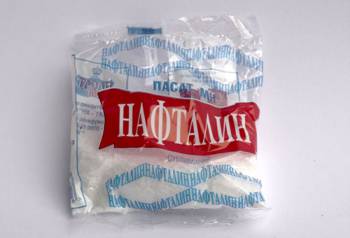

After a few hours, it is required to ventilate the room well, wipe all surfaces of the cabinet with a damp cloth and spread the moth repellent tablets.
Be sure to read the instructions that came with the spray can, otherwise insufficient time before airing can interfere with the complete disposal of pests.
If a clothes moth has started up in the kitchen, you should be extremely careful when using aerosols to prevent the poison from getting on the food. Before you destroy a grain or fruit butterfly, you need to carefully review all containers with cereals, dried fruits and other food products. Contaminated food should be discarded immediately.
Why is moth afraid of pungent odors
There are 2000-3000 species of real moths in the world. They live in caves, animal holes, bird nests. Their larvae eat grain, mushrooms, keratin, which is contained in the wool of animals and feathers of birds.
For humans, the greatest danger is posed by domestic species of moths. Some live in wardrobes and furniture. These are clothes, fur and furniture moths. Others live in the kitchen, where they spoil food supplies: flour, grain, mushroom, fruit moth.
The small butterflies flitting around the room are males. Females move little and hide in clothing and food. In adult insects, the mouth and digestive apparatus are atrophied. They do not eat anything and use up the reserves accumulated when they were larvae. The caterpillars of the moth are distinguished by powerful jaws and a huge appetite. To get to food, they even gnaw through plastic wrap and dense fabric.
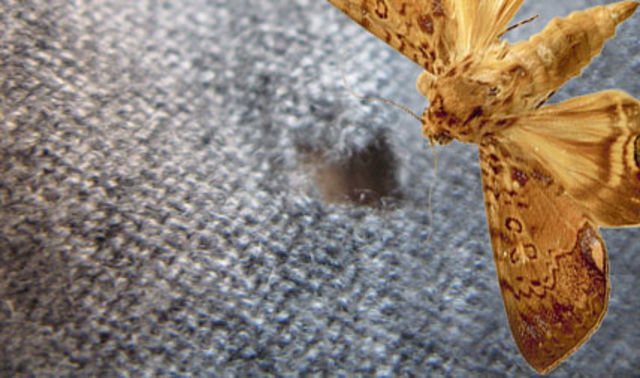

Moth butterflies have a highly developed sense of smell. Sensilla - powerful olfactory organs - are located on the legs and antennae of insects. They are 100 times more sensitive than human ones. The harsh and strong odors emitted by chemical and plant repellents drive moths away from kitchens and wardrobes. A butterfly that has flown through the window, which is looking for a place to lay eggs, this smell will make it leave the room.
Chemicals for moths
Chemicals are also used to combat moths.Almost all of these insecticides are made on the basis of pyrethroids - poisons that have a nerve-paralytic effect. They are made in the form of tablets, aerosols, insect traps, etc.
- One of the most powerful poisons is dichlorvos (many drugs produced under this name are not actually dichlorvos). They need to process all clothing where room moth larvae have been found. Remember to follow the safety instructions on the packaging. For prevention, Dichlorvos and other aerosols (for example, Moskitol, Armol, Taiga, Raptor, etc.) should not be used, because their smell quickly disappears and it will not bring any harm to insects - but it can for you and your household.
- The drugs that fight the larvae and adults of the clothes moth are also moth plates - small cardboard boxes soaked in substances poisonous to insects: Antimol, Dr. Claus, etc. They are laid out in the places where the moth and its larvae live on the upper shelves, because the smell descends from top to bottom. Once every few months, when the effect of the drug decreases, the plates are replaced with new ones.
- Many drugs against room moth (tablets and balls) are used as a prophylactic agent: they repel the insect. There are also many drugs that contain old, but not so good naphthalene. The poison that secretes naphthalene in large quantities can cause poisoning and adversely affect the functioning of the liver, pancreas and other organs. Therefore, it is dangerous to use it in places where there are children.
- Sections are also used as repellents - agents with a deterrent smell in them are in a special case, which can be easily attached to the wall of the cabinet (adhesive tape at the bottom) or hung by a hook on a clothes rail.
How to remove moth larvae: chemicals and folk methods
Hearing the word moth, people have associations with spoiled clothes, a fur coat, etc. It is the moth larva that harms, it destroys all natural fabrics: wool, fur, cotton, leaving huge holes and bald patches.
Their fur products become trimmed and lose their appearance. In general, after the sabotage of moth larvae, clothing becomes unusable. Today, about how to get rid of moth larvae, the most proven and effective ways to combat them.
Features of moth larvae
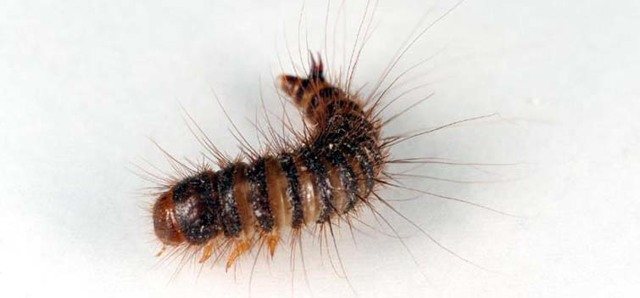

By itself, a moth does no harm, it does not have any mouth at all, and the insect does not feed during its life.
But they are able to lay eggs, from which voracious larvae hatch later, which, during their vital activity and before turning into an adult insect, must accumulate a sufficient amount of nutrients in order to subsequently mate and lay new eggs.
Appearance and species differences
Scientists identify several types of moths, which have some discrepancies in appearance and which will help determine which pest has settled in your home.
- wardrobe - gives taste preferences to products made of felt, felt and wool;
- furniture - it can be easily found in upholstered furniture;
- carpet - the name speaks for itself, in its taste are carpets, rugs and rugs;
- fur coat - if you have a beautiful fur coat, then you will have to say goodbye to it;
- kitchen - this species eats all the edible supplies in the kitchen in the form of cereal and cereal supplies, as well as seeds, dried fruits, berries, nuts.
Outwardly, representatives of these species resemble a small worm, about 10 mm in size. Their body is white or yellowish in color. At one end there is a very hard, dark brown head with clearly visible jaws. But, as we know, worms lack limbs.
And each larva has six pairs of legs, with the help of which they move quickly, so it is better to call them small caterpillars.Another feature of moth larvae is the formation of a cocoon. The wardrobe, fur coat larvae weave a cocoon of textile fibers, put it on themselves. And so they exist.


The food caterpillar builds passages from food debris and its own excrement. On this basis, you can also determine which species is pesting in your room.
Such characteristics help to choose one or another means of fighting moths. All larvae have a difference - this is the choice of habitat and preferences in taste. If you have a kitchen larva, then it will not spoil clothes and carpets, similarly to a fur coat, a wardrobe, etc.
Life cycle
Each stage of moth development has a different duration, which depends on environmental factors. The life cycle of each butterfly consists of four stages.
The optimum ambient temperature for the fruitful life of the larva is 23-25 degrees.
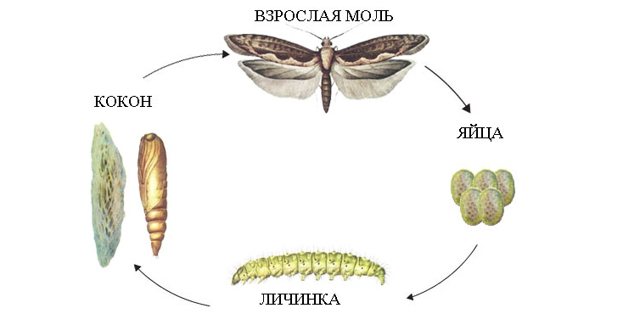

In this case, the duration of development of the caterpillar is about three months, and the total period from egg to egg is six months. If the temperature is increased to 30 degrees, then during the same period the moth will multiply twice as fast. At a lower one, the term of development increases.
Important! If the temperature in the room is below 13 degrees or above 30 degrees, the moth and its larvae can die.
The food type of moth goes through all stages much faster, since their food is more nutritious. As soon as the larva accumulates the required amount of nutrients, it leaves its cocoon, becomes a butterfly and is able to mate to produce further offspring.
Another feature of butterflies is the death of a partner after mating, and of a female after laying eggs. That is why nature has deprived adults of the mouth and the ability to feed. But they are very good at laying off future offspring, the number of which ranges from a few pieces to several hundred.
These eggs appear after a week and begin their sabotage. With such a number of future larvae, it is difficult to imagine the scale of the destruction, if you do not take control measures in time.
Food
The food for moth caterpillars is quite varied. In the wild, these can be: wool of wild animals, bird feathers, berries and fruits, nuts and plant seeds.
When living in a house, this list becomes more diverse. It is joined by fur coats, textiles, furniture, balls of woolen threads, sheep's wool, cereals, dried fruits, medicinal herbs, etc.
The larvae are not averse to feasting on silk and flax products. Crawling in carpets, they can feed on human hair, which falls off the head, and they do not disdain synthetics. Although they will not eat it, they do not mind spoiling it.
Important! Most of the larvae can be found in dirty clothes made from natural fabrics, as well as dirty floor coverings. By eating the fabric, they receive a sufficient amount of moisture in the form of sweat, spilled liquid.
Residential species
The moth is a keratophagous insect (it feeds mainly on the horny substance contained in woolen and fur products), but at the same time it does not disdain the pest and organics.
It enters the apartment in various ways:
- with low-quality, already infected larvae of the pest with food (he especially loves moths of cereals, dried fruits, flour and sugar);
- through vents from neighbors;
- together with clothing, in the folds of which ovipositions may be;
- on pet hair;
- with books from libraries.
It doesn't matter what clever ways this nondescript butterfly has penetrated into your home, it is important what damage it can cause in the form of spoiled carpets, fur coats, things made of expensive natural fabrics. Most often, the following types of this pest live in apartments:
Most often, the following types of this pest live in apartments:
- Fur coat (woolen).
The color of this butterfly is gray-yellow with small black specks on the wings. A favorite place of the settlement is wardrobes.To get to fur things, it can even gnaw through polyethylene. In the absence of tasty clothes, it can feed on books, pillow feathers and felt. - Furniture.
The color of the wings is yellowish with a characteristic golden tint. Lives mainly in upholstered furniture, eats furniture fabric, but never gives up fur and wool. - Wardrobe.
The wings of this insect are colored yellow with a purple tint. It lives in dark wardrobes, where it eats all clothes indiscriminately, leaving ugly holes on the entire surface. - Food (grain, fruit).
A small butterfly of the fire family. The wings are gray with specks or brown stripes. It is not only engaged in the destruction of food (cereals, legumes, tea, flour, nuts, sugar), but also infects food with its excrement, skin particles, and caterpillar husks. Food after moth infestation is unfit for consumption and can cause severe intoxication in humans.
There is also a wax moth. It lives in bee hives and does a lot of harm, but the tincture based on its larvae has many medicinal properties.
IMPORTANT! An adult moth is incapable of causing damage. She does not have a mouth apparatus, she is generally deprived of the opportunity to eat and digest food
Its main task is to lay eggs, from which gluttonous caterpillars hatch, sweeping away everything in their path.
What a mole looks like, photo below:
Close acquaintance with the enemy
The family of true moths (Tineidae) has 2000-3000 species. These butterflies are found everywhere, eating dry mushrooms, grains containing keratin, animal remains (fur, wool, down, feathers). You can meet representatives of the family in animal burrows, bird nests, bat caves. But for a person, the most unpleasant neighbors in the apartment are the wardrobe, fur coat, carpet and food moths, the varieties of which they prefer to live in the kitchen: grain, fruit, flour.
A reliable fact is described when a moth ate dried snake venom without harm to itself. There are legends about the omnivorous nature of the moth, but it eats only those things or products where colonies of mold fungi are found.
Repellent plants do not kill the insect, but scare them away with their smell. On the antennae and even the front legs of the moth, there are many sensilla - olfactory elements that are able to catch odors in the slightest concentration. The sensitivity of the organ of smell in butterflies is 100 times greater than that of a human. Therefore, a strong smell can scare away insects from the closet with clothes or cereals.
The butterflies flying in the apartment are mainly males. Females prefer to hide in folds of clothes and crawl from one thing to another. The imago is an adult insect that does not spoil food or tissue, since its digestive organs and oral apparatus are reduced. The main enemy is the moth larva. Developed jaws allow her to gnaw holes even in plastic bags that protect things.
Prevention methods
If you adhere to some rules, you can completely prevent the appearance of pests in the apartment. Moreover, they are completely uncomplicated, but lead to order and cleanliness.
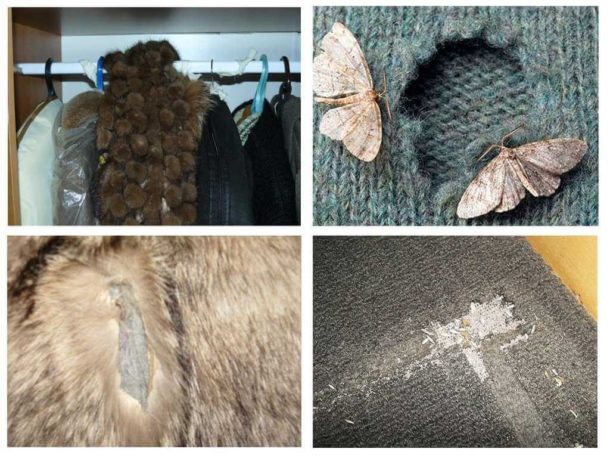

It is necessary:
- Regularly carry out thorough wet cleaning in the apartment.
- Inspect things carefully when buying. Especially if it is clothes with fur, fur coats, felt products.
- Stay alert when purchasing furniture, carpets and food.
- Store cereals, flour and other groceries in a sealed container or refrigerator.
- It is advisable not to accumulate large stocks of food and closely monitor their expiration date.
- Pre-wash items before storing them in the closet for the winter.
- Shake warm wool and fur items well.
- Fur coats are best stored in paper covers, and woolen and fur clothes must be securely packed in plastic bags, after putting in them anti-moth products (preventing its appearance), fabric bags that have been washed with laundry soap are suitable for storing hats.
- If possible, purchase hangers made of cedar, which is a strong repellent.
- For prophylaxis, arrange bags of lavender, citrus peels or bags with spices in cabinets and on shelves.
- Ventilate the room as often as possible and try to keep things on the balcony in frosty and sunny weather.
- Periodically check things that have not been removed from the closet for a long time, and, similarly, look at food stocks (especially if they are stored in dark places).
- Do not arrange at home (wardrobes, dressers, bedside tables) a storage of old things, which can become a "resort" for moths.
Lemongrass
Lemongrass also repels mosquitoes. You've probably noticed the shelves in stores filled with citronella candles in the summer.
Citronella is a natural oil found in lemongrass, an ornamental plant that can grow up to 4 feet high and 3 feet wide in one season.
This herb (great for culinary use) only survives comfortably in South Florida, so you will have to grow it as an annual plant.
Lemongrass will do well in a pot or in the ground in a sunny, well-drained place. Take this opportunity to use its aromatic leaves in chicken and pork dishes, as well as in aromatic soups and salad dressings. Many Asian recipes are not complete without lemongrass.
Output
Fighting moths is not a matter of one or two hours or even a whole day. The main thing is not to panic right away, but to focus on the phased destruction of the pest. First of all, it would be good to find the reason for the appearance of moths in the apartment, then you will have to start revising all stocks, inspecting things, general cleaning, etc. A lot of insects have already bred or not enough - you should not relax. Even one or two individuals can turn an apartment into a haven for hundreds of "kids". But even in this case, it is possible to defeat the moth.


You should not neglect putting things in order in the house, it is better to once again make sure of the quality of the products when buying or review your things, you can put lavender flowers or mint sprigs on the shelves with clothes, use ready-made tablets or Velcro. For a cardinal struggle, feel free to use new effective means.
Do not give up - and everything will work out. We really hope that our article will help you find the correct and effective solution to the problem.
What plants will help fight moths
Repellent plants can be found everywhere. They grow in meadows and fields, bloom in a flower bed near the house, decorate apartment windowsills. Many of them have long been used as an effective folk remedy for moth control. Let's consider in detail where you can find helpers.
Wild-growing repellents
Sagebrush. On the sides of the roads, on the fallow lands and between the fields, you can find silvery wormwood bushes. Its strong specific aroma scares away not only the clothes moth. Wormwood has long been used as an insecticide and phytoncide in the fight against pests in the garden and vegetable garden. No wonder the English name of the plant (wormwood) is made up of two words, which in translation mean worm - worm, wood - wood, forest. To combat moths, the aerial part of the plant is used, dried in a shaded, ventilated place. The twigs can be laid out in closets or made sachets, which can be hung on hangers, placed in the pockets of fur coats or inside bags with woolen clothes. Wormwood from moths needs to be changed periodically, as essential oils evaporate over time. Now flower growers have bred and cultivated varieties of decorative wormwood, which retains the properties of an insecticide, but has very unusual spectacular leaves. The plant can be grown as an indoor plant, then it will fight insects throughout the growing season.
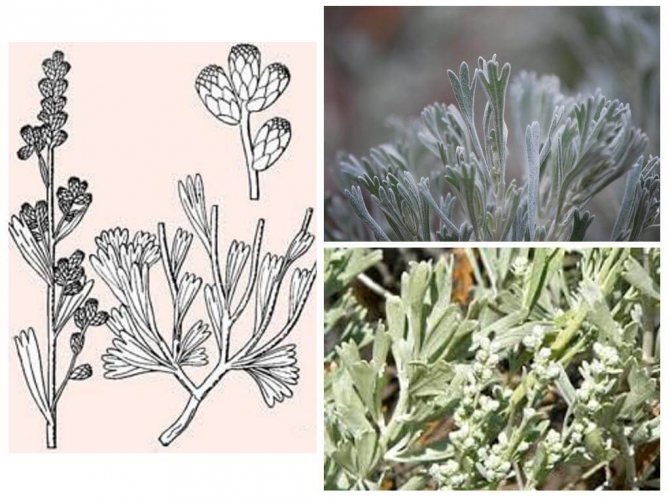

Sagebrush
Sorcerers believe that in a house in which a lot of moths have appeared, there is a dysfunctional energy. The dark aspects of the consciousness of the owners of the house are activated, which do not allow dreams and desires to come true. Wormwood, magicians use to cleanse the spirit of a person from filth - to cleanse a person, it means that the moth will disappear.
Donnik. In addition to wormwood from moths, medicinal sweet clover is used. Clothes are sprinkled with dry grass and flowers of sweet clover.The popular name of the plant is molten grass. Due to the large amount of coumarin, the flowers of the plant have a pleasant, persistent aroma.
Oregano. For a long time, when putting clothes in a chest, housewives were shifting things with dry flowering branches of common oregano. The insecticidal properties of the plant reflect the popular names. So in Bashkiria oregano is called flea, and in Karelia - bedbug grass.
Chamomile. Adults and larvae are afraid of the smell of chamomile. Among the species diversity of this plant, three types of chamomile - Dalmatian, pink and meat-red are used not only among the people. On the basis of powder from crushed flower baskets, an insecticidal preparation for the fight against household insects is industrially produced - Flitsid. Chamomile powder - pyrethrum is used to prepare an alcoholic extract or pyrethral extract. Adding a small amount of the extract to the rinse water will keep the woollens from pests. From pyrethrum, you can make sachets - fabric pads filled with fragrant powder.


Moth herbs
Marsh Ledum. In spring, peat bogs and wet forest clearings are covered with a fragrant white carpet. This is the marsh rosemary in bloom. From moths, dried crushed flowers are used and at the same time branches of wild rosemary are laid out on the shelves. From flying butterflies, fumigation with powder of plant leaves is used.
Among wild plants, many have insecticidal properties:
| Plant name | Applicable part | Term of use |
| Tansy | inflorescences | 1.5-2 months |
| Mary antihelminthic | Flowers, grass | 1.5-2 months |
| Canadian small petals | Flowers, grass | 1.5-2 months |
| Nivyanik | Flowers, grass | 1.5-2 months |
| Thermopsis lanceolate | Flowers, grass | 1.5-2 months |
| Yarrow | Flower baskets, grass | 1.5-2 months |
| Lavender | Flowers, essential oil | 1.5-2 months |
| Norway spruce | Escapes | 1-1.5 months |
| Balsam fir | Shoots, essential oil | 1-1.5 months |
| Horse chestnut | fruit | Until next season |
| Wild strawberry | Soap, dry perfume | As the smell disappears |
Indoor flowers for pest control
Well-known houseplants are distinguished by their preventive properties from moths. They secrete phytoncides that drive away these insects.
Geranium
The smell of lush geranium buds and leaves is unbearable for moths. To ward off insects, the plant is not even placed in cupboards. It is enough to put one pot of geraniums in each room and in the kitchen, and a fur coat, clothes, food moth will not appear in the house. All varieties of geraniums differ in properties that drive away insects. To enhance the anti-malignant effect, fresh leaves are placed on the shelves of the cabinets. But they should be changed frequently as dry plants do not smell.
This graceful tree blooms profusely and smells like lemon. Its flowers give off aldehydes that repel moths butterflies. These substances give myrtle essential oil a delicate lemon scent. To protect against pests, cotton pads or pieces of cloth are impregnated with myrtle oil and laid out in cabinets. They give things a pleasant scent.
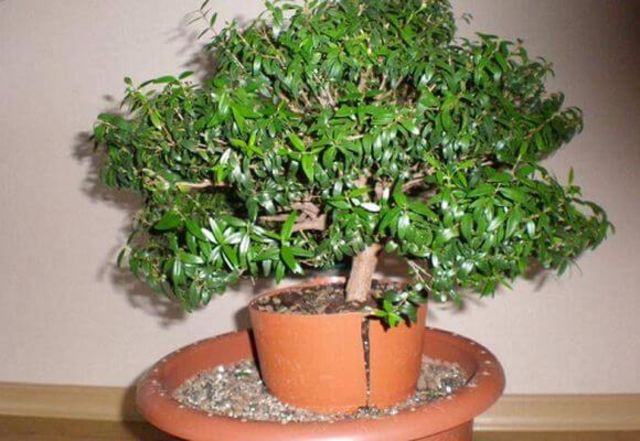

Lily
This flower scares away moths with a delicate aroma. Liliaceae such as amaryllis, hymenokallis, hippeastrum are grown in indoor flowerpots. Where these flowers grow, moths will not start.
Plectrantus
The plant with velvety oval leaves is popular with gardeners because of its unpretentiousness and decorative qualities. Its aroma is similar to mint, lemon balm or lemon. It is not for nothing that Plectrantus is called the "molar tree" - all plant species have good insecticidal properties. Plectranthus shrub affects insects the most.
Using indoor flowers
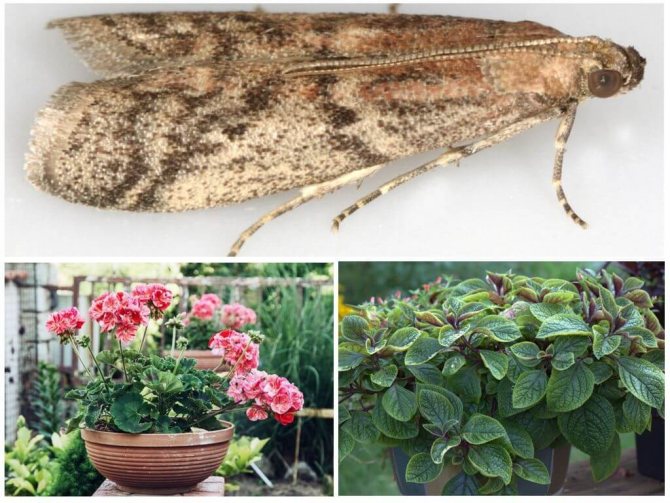

Houseplants from moths
One of the effective ways to prevent the appearance of a pest is to use indoor flowers from moths, which will delight the owners not only with their blooming appearance, but also save the house from invasion.
Popular decorative flowers that repel moths:
- Geranium - this flower scares away moths, feels great at home in a pot, preferring well-lit places in the house: window sills, etc. Plucked leaves, which give off a pungent smell when pressed, are recommended to be spread among the clothes in the wardrobe, however, after drying, the aroma decreases. and they will have to be replaced with fresh ones. Stores also sell geranium oil, which is recommended to be added to water and to wipe shelves and walls inside dressers, cabinets and other furniture.
- Decorative lily is an indoor flower from moths, which many lovers grow on the windowsill in an apartment, emitting a pungent aroma that is not tolerated by pests. No wonder, even in Ancient Greece, these flowers were considered a symbol of tenderness and purity.
- Plectrantus is an exotic shrub brought by flower growers from South America, in our climate it grows only indoors, is unpretentious to care for, and its green parts emit a smell similar to a mixture of lemon, mint, lemon balm and camphor, thanks to which it cleans the air well and scares away flying pests.
- A small myrtle tree, emitting a pleasant lemon scent that contains the aldehyde citral and citronellal, repels moth moths. You can soak cotton balls with myrtle essential oil and spread them between clothes on the shelves.
Branches of fragrant flowers must be often replaced with fresh ones or put away from other plants, since the moth gradually gets used to them.

